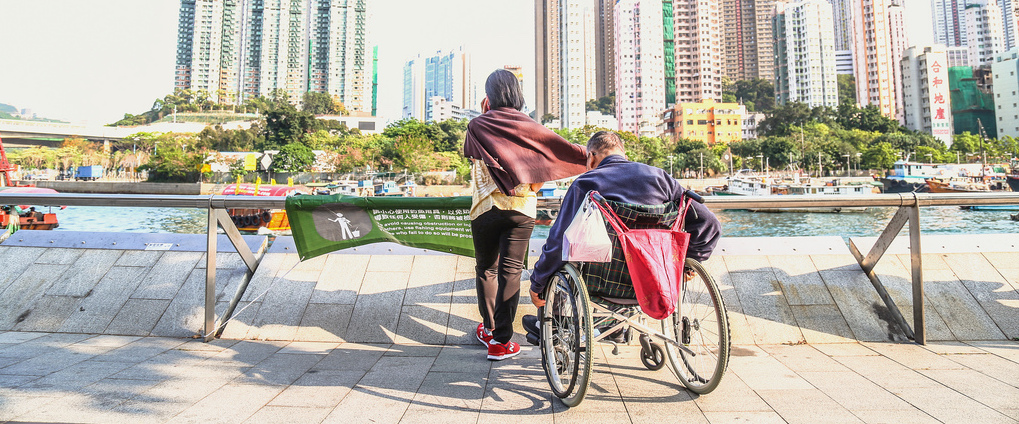This blog post by Wong Yu-Cheung (husITa board member, and Associate Professor in social work at the Chinese University of Hong Kong) explores the opportunities and constraints influencing the adoption of geron-technology in Hong Kong.
Technology has enormous potential to improve the functional ability of older people, especially those who need long-term care services. This potential has yet to be realised in mainstream elder care services in Hong Kong, but it has started to attract more attention. In June of this year the Hong Kong Council of Social Services (HKCSS), with the support of the Government, organized an expo on geron-technology. This was the first event of its kind and attracted 45,000 visitors. Similar kinds of expos and trade fairs have been held in Japan, Taiwan, mainland China and, South Korea. Hong Kong is relative late comer.
Geron-technology includes technologies that assist older people to: mobilise at home and outdoors, transfer from bed to chair, take care of their daily living needs (such as toileting, bathing and eating), monitor physical and physiological conditions and stay connected with the outside world. Geron-technology also includes tools to help professionals and care givers provide training and rehabilitation, as well as managing service delivery in institutional and community care settings.
Traditionally, in East Asia, most care work is undertaken by the elderly person’s spouse, children or children-in-law, especially female family members. Heavy personal care duties require dedication and sacrifice on the part of care givers. This traditional, informal, family care arrangement is becoming unsustainable for several reasons. Firstly, smaller family sizes, lower fertility rates and more children working far away from home mean that fewer family members are available to offer care. Secondly, the extended longevity enjoyed more and more older people means that many are living to a stage when they require long-term care. And, thirdly, as a result of longevity, the off-spring of older people are themselves elderly when they have to take up care duties that prove too demanding for most.
East Asian countries have the fastest growing elderly population in terms of both numbers and proportion. So, having a good long-term care policy is an urgent concern. Within 10 to 15 years most East Asian countries will have over 25% older people in their population. Japan reached this level a few years ago and has set a very good model for other East Asian countries and regions in terms of their Long-Term Care (LTC) insurance system and the support given to older people to acquire assistive technology and subsidise home adaptations to accommodate their physical needs. This policy has been in existence since the year 2000 and has created a huge market for assistive technology and care system products and innovations.
Since they share a similar culture and living environment, many innovations in assistive technology and care systems in East Asian countries have greater transferability within the region than outside. For example, since most older people live in small apartments, the size of the assistive equipment is of greater concern. Large bathing tubs and wheelchairs are not suitable and collapsible equipment is better adapted to the small spaces in homes and outdoors. Another example is that, since many older people live in multi-storey apartments without lifts, devices that allow wheelchairs to climb old, long and narrow staircases, are of particular value. In fact, there are NGOs in Taipei and Hong Kong that have started running small scale on-call services, partially supported by the local government. Demand will be huge if the scale of such services can be enlarged.
However, the extensive application of technology in day care centres, and homes for older people is still rare, even in Japan. In a recent visit to a residential institution dedicated to experimenting with technology in the care of the elderly, I saw care givers use an exoskeleton suit to help move an older person from a bed to a wheel chair. However, no elderly care home has adopted this technology. One reason is that most care givers working in elderly homes are middle-aged, and are not very comfortable using such devices. Also, elderly care homes are unlikely to invest in such technologies unless the costs are covered by insurance payments.
In the case of Hong Kong, the government budget for long-term care is less than 0.3% of its GDP, compared with 2% in Japan. Also, programmes to support the adoption of technology in elderly care is limited in funding and scale. Without sufficient government support, the market for assistive devices is almost non-existent in terms of product innovation and sales. Poverty amongst older people and limited retirement protection (30% of the elderly are income poor even after government cash transfers) limits the mass adoption of assistive devices. As a result, older people in Hong Kong cannot benefit from the improvements in functional ability and quality of life that technology can provide. Some senior government officials have spoken about the constraints and opportunities on the adoption of geron-technology, we can only hope that actions will follow their words.
What is clear is that, with the ever growing number of older people in the population, and a shrinking labour force, geron-technology has great potential to improve the functional ability and quality of life of older people. The adoption of policies that could support technology innovation and adoption is now imperative.
Image credit: Bailey Cheng


3 comments for “Gerontechnology: Great potential, but limited adoption in Hong Kong”